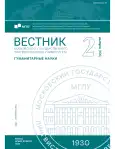Hagi Flowers as the Most Common Plant Name in Ancient Japanese Poetry
- Authors: Egorova O.G.1, Tumakova T.V.1
-
Affiliations:
- Moscow State Linguistic University
- Issue: No 2(896) (2025)
- Pages: 119-125
- Section: Literary criticism
- URL: https://journal-vniispk.ru/2542-2197/article/view/284014
- ID: 284014
Cite item
Full Text
Abstract
The aim of the study is to analyze the poetic image of hagi flowers in ancient Japanese poetry. The article, based on the first Japanese poetry anthology “Man’yōshū”, reveals the symbolic variability of the hagi flower image and defines its place and role in ancient Japanese poetry. Research results: the analysis showed that this image in ancient poetry not only served as a symbol of autumn and a signal of the onset of the harvest season, but was also used as a metaphor for a young girl, a lover, and a wife. Images of a deer, dew, autumn wind, geese, etc. could also be used as words complementing the poetic image of hagi. In addition, the word “hagi” could be part of such expressions as, for example, “shirahagi” and “hagi-no momichi”, meaning autumn and autumn foliage.
Keywords
About the authors
Olga Gennadevna Egorova
Moscow State Linguistic University
Author for correspondence.
Email: o.g.egorova@linguanet.ru
Doctor of Sciences (Philology), Professor, Professor at the Department of Russian and Foreign Literature
Russian FederationTatiana Vladislavovna Tumakova
Moscow State Linguistic University
Email: fedotova.tv@gmail.com
Postgraduate at the department of Russian and Foreign Literature
Russian FederationReferences
- Meshcheryakov, A. N. (2004). Kniga yaponskikh simvolov. Kniga yaponskikh obyknovenii = The book of Japanese symbols. The book of Japanese customs. Moscow: Natalis. (In Russ.)
- Omura, K. (Ed.). (1998). The Kodansha bilingual encyclopedia of Japan. Tokyo: Kodansha International; New York: Kodansha America.
- Sasaki, Yu. (2016). Vremena goda v Yaponii. Puteshestvie v tsvetochnyi rai. Man’yosyu: girlyanda iz tsvetov = Japan in four seasons. Journeys to floral paradise. Man’yoshu: a garland of flowers. Niponiсa. 19, 18–19. (In Russ.)
- Konrad, N. I. (Ed.). (1999). Bol’shoi yaponsko-russkii slovar’ = Full Japanese-Russian dictionary (vol. 2): in 2 vols. Moscow: Zhivoi yazyk. (In Russ.)
- 山口明穂、鈴木日出男。王朝文化辞典:万葉から江戸まで。東京、 2008 = Yamaguchi Akiho, Suzuki Hideo (2008). Dictionary of imperial culture: from Man’yō to Edo.
- 復本一郎。季節の言葉辞書:四季別・50音順。東京、2004 = Fukumoto Ichiro (2004). Dictionary of seasonal words: seasonally, alphabetically. Tokyo.
- Ermakov, M. E. (2003). Magiya Kitaya. Vvedenie v traditsionnye nauki i praktiki = Magic in China. Introduction to traditional sciences and practices. St.Petersburg: Azbuka-klassika, Peterburgskoe Vostokovedenie. (In Russ.)
Supplementary files










